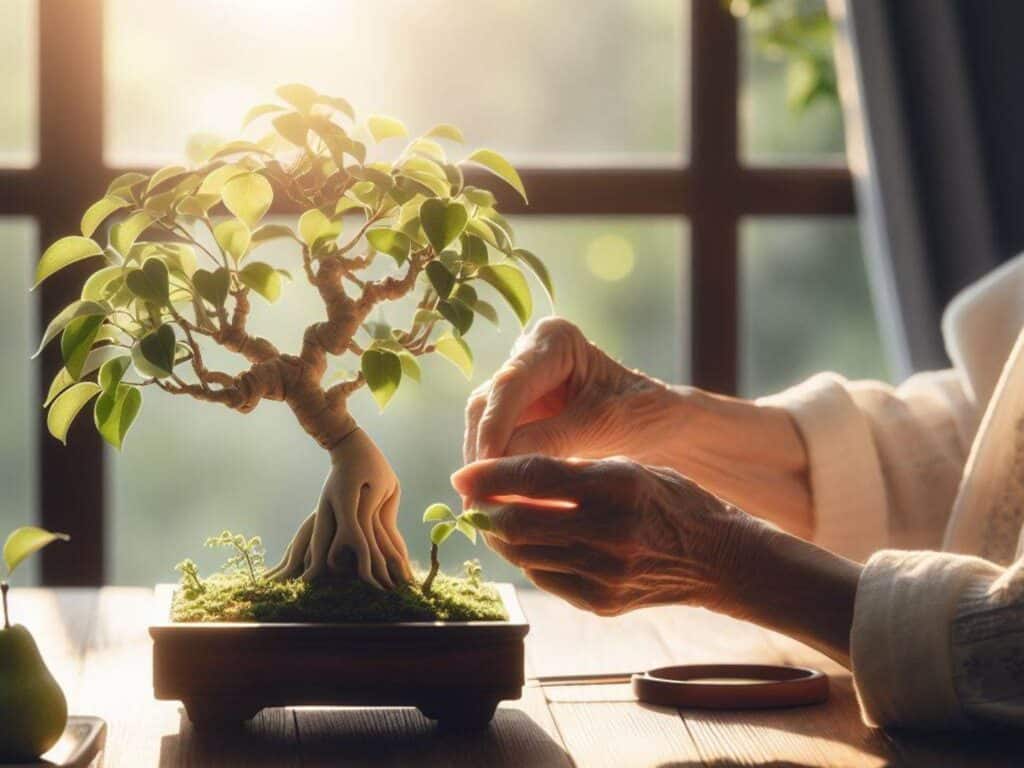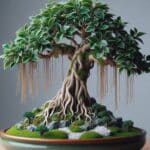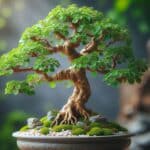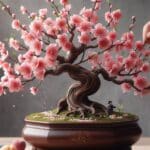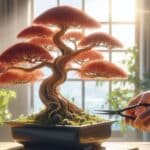Pears are delicious fruits that people across the globe frequently enjoy. Surprisingly, the common pear bonsai tree isn’t that common. In truth, this plant species is rarely used for growing miniature trees since young plants can be challenging to come by.
Even though this isn’t the most common or popular bonsai species, it is still a suitable plant for these types of techniques.
A little pet pear tree can bring great joy since this flowering bonsai can highlight your day with beautiful crisp white blooms and offer a lot of interest when the foliage transforms into reddish hues right before its dormancy state.
You can also grow it for its special meaning. Pear trees are a symbol of abundance and longevity and can help attract lots of positive energy.
Let’s look at the best way to grow and care for this interesting fruit bonsai tree.

Plant Facts
| Scientific name | Pyrus communis |
| Common names | Common pear, pear bonsai |
| Family | Rosaceae |
| Plant Type | Fruit tree |
| Height and Width | 35 ft. tall (natural), 1–3 ft. tall (bonsai) |
| Origin | China and Asia Minor |
| Flower colors | White |
| Foliage color | Light green, dark green, and shades of red |
| Sun Exposure | Outdoor bonsai, direct or indirect light |
| Soil Type & pH | Well-drained, bonsai soil mix |
| Special features | Produces beautiful blooms and bright autumn foliage colors |
What Does a Bonsai Pear Tree Look Like
Some of the most iconic characteristics of pear trees are their beautiful white flowers that appear in early spring. These mini trees can bloom excessively and might even develop an edible fruit you can enjoy. While you can use techniques to miniaturize the entire tree, keeping the fruits small isn’t possible. Your little tree might develop one or two overly large fruits during the growing season. Depending on the variety, this fruit can transform from green to brown or yellow.
The mini trees typically have gray/brown or reddish/brown bark with simple bright green foliage that can transform into golden or red hues during autumn.
Where to Grow a Bonsai Pear Tree
The pear is an outdoor bonsai because it needs lots of direct sunlight in order to bloom or develop fruits. You can protect the tree in warm areas with a thin shade cloth. There is no need to bring this tree indoors for the winter since it can tolerate extremely cold temperatures as low as 25 degrees F.

How to Grow a Pear Bonsai Tree
The best way to start a bonsai tree is to purchase a young tree from a local nursery. Saplings are relatively affordable and strong enough to survive the many techniques required to keep these trees nice and small. Let’s take a look at how to develop your one-pear bonsai.
Propagation
You can propagate a pear tree from seed or from cuttings. For commercial applications, these trees are usually grown from grafting because a grafted tree can start to bear fruits within a year while a seedling can take up to 7 years to bear fruit and a cutting usually takes about 1 – 3 years to produce fruits.
Soil
Pear trees can grow well in average soil conditions with a pH of 7. They can also grow well in fertile, sandy, or loam soil types if the pH level is slightly lower.
Since you will be planting the pear tree in a small container, creating a nutrient-rich soil that drains well is probably best. A standard bonsai soil mixture should work fine if the plant is placed in a container with many drainage holes.
Pruning
Regular pruning is necessary to maintain the shape of this little tree. Pruning will also ensure that all the leaves will get enough direct sunlight.
This type of bonsai species can be trained into most bonsai styles. The informal upright and slanting styles are trendy for this tree species.
Repotting and Transplanting
A young pear tree should be repotted every 2 – 3 years while mature trees can be repotted every 3 – 5 years.
The best time to repot this type of tree is during early spring before the tree starts to bloom or in mid-summer when the blossoms have been spent.
If you repot the tree while it is in bloom, it will lose all its flowers.
Your little tree should be placed in a proper bonsai pot with a flattened design. The pot should have plenty of drainage holes since pear trees don’t like waterlogged conditions.
Always use fresh potting soil when repotting the tree and prune the roots so the root system will have lots of space to grow and develop.
How to Care for a Bonsai Pear Tree
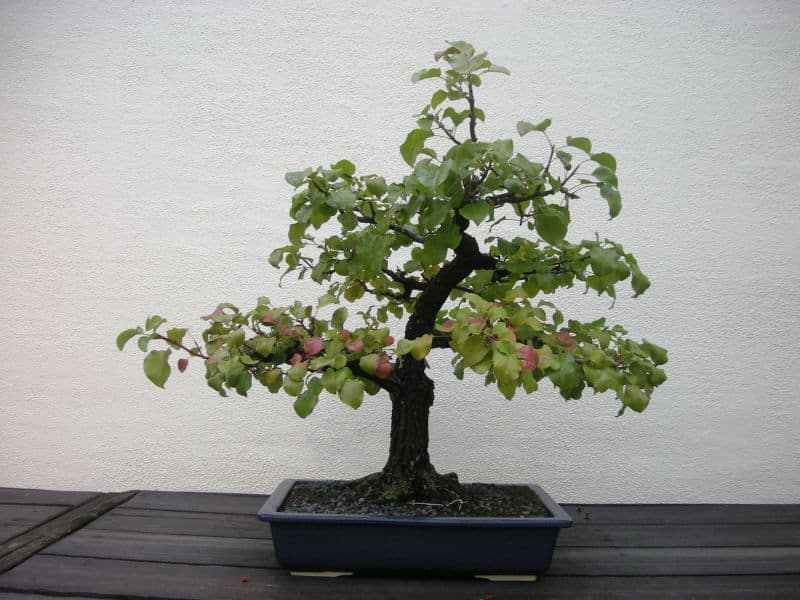
Bonsai pear trees are not too difficult to care for. They are slow growers and it might take some time before you will see significant growth but their needs are pretty basic. Let’s take a look at how to care for this type of bonsai.
Water
The root ball of your pear bonsai should never dry out completely or the tree can die. Pears like plenty of moisture and prefer moist soil. Even though they like plenty of moisture, the tree shouldn’t be overwatered or it can develop root rot.
It is usually best to wait until the top inch of the soil has dried out before watering the plant again.
Sunlight
These trees need plenty of direct sunlight to stay healthy, bloom, and produce fruits. You can keep the little tree in a partial sun position where it will receive 4 – 6 hours of direct sun per day. In particularly hot regions, you can use a thin shade cloth to protect the delicate foliage.
Temperature and Humidity
These small trees are exceptionally frost tolerant and can be kept outside throughout the winter. They can withstand relatively high temperatures but should be protected if it gets too hot.
The little trees like a humidity level of 40% – 50%. To recreate this high humidity level, you can place the little tree inside a humidity tray on top of some small pebbles.
Fertilizer
Since the little tree has limited nutrients and resources, it is usually best to fertilize it regularly. During the growing season, you can add a slow-release organic fertilizer once a month or you can offer it some liquid fertilizer once a week.
Pests and Diseases
These tiny trees have delicate foliage and can be vulnerable to a variety of pests. Pests like pear psylla and spider mites are especially common problems with this tree species.
Common Varieties and Cultivars
Over 3,000 different varieties of pear fruit trees are grown worldwide but only a small handful of these species are typical for bonsai growing. The two most popular varieties among bonsai enthusiasts include the common pear (Pyrus communis) and the Bradford Pear (Pyrus calleryana) since these trees have a smaller stature and more delicate leaf pattern. Here is a quick look at some other species that can be used for growing bonsai.
- European Pear (Pyrus domestica)
- Brown Nashi Pear (Pyrus pyrifolia)
- Concorde Pear (Pyrus communis ‘Concorde’ D)
- Dwarf Seckel Sugar Pear (Pyrus communis ‘Seckel’)
Conclusion
Pear bonsai trees are not the simplest to grow but they can offer a lot of charm when their fragrant flowers start appearing during early spring. These outdoor bonsai trees can look quite striking in your garden and it can be a fun experience to grow and care for the little tree.

